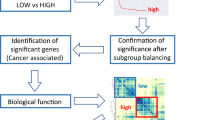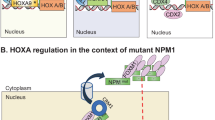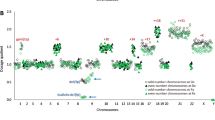Abstract
Deregulated HOX expression, by chromosomal translocations and myeloid-lymphoid leukemia (MLL) rearrangements, is causal in some types of leukemia. Using real-time reverse transcription-PCR, we examined the expression of 43 clustered HOX, polycomb, MLL and FLT3 genes in 119 newly diagnosed adult acute myeloid leukemias (AMLs) selected from all major cytogenetic groups. Downregulated HOX expression was a consistent feature of favorable AMLs and, among these cases, inv(16) cases had a distinct expression profile. Using a 17-gene predictor in 44 additional samples, we observed a 94.7% specificity for classifying favorable vs intermediate/unfavorable cytogenetic groups. Among other AMLs, HOX overexpression was associated with nucleophosmin (NPM) mutations and we also identified a phenotypically similar subset with wt-NPM. In many unfavorable and other intermediate cytogenetic AMLs, HOX levels resembled those in normal CD34+ cells, except that the homogeneity characteristic of normal samples was not present. We also observed that HOXA9 levels were significantly inversely correlated with survival and that BMI-1 was overexpressed in cases with 11q23 rearrangements, suggesting that p19ARF suppression may be involved in MLL-associated leukemia. These results underscore the close relationship between HOX expression patterns and certain forms of AML and emphasize the need to determine whether these differences play a role in the disease process.
This is a preview of subscription content, access via your institution
Access options
Subscribe to this journal
Receive 12 print issues and online access
$259.00 per year
only $21.58 per issue
Buy this article
- Purchase on Springer Link
- Instant access to full article PDF
Prices may be subject to local taxes which are calculated during checkout


Similar content being viewed by others
References
Boissel N, Renneville A, Biggio V, Philippe N, Thomas X, Cayuela JM et al. Prevalence, clinical profile, and prognosis of NPM mutations in AML with normal karyotype. Blood 2005; 106: 3618–3620.
Falini B, Mecucci C, Tiacci E, Alcalay M, Rosati R, Pasqualucci L et al. Cytoplasmic nucleophosmin in acute myelogenous leukemia with a normal karyotype. N Engl J Med 2005; 352: 254–266.
Gari M, Goodeve A, Wilson G, Winship P, Langabeer S, Linch D et al. c-kit proto-oncogene exon 8 in-frame deletion plus insertion mutations in acute myeloid leukaemia. Br J Haematol 1999; 105: 894–900.
Goemans BF, Zwaan CM, Miller M, Zimmermann M, Harlow A, Meshinchi S et al. Mutations in KIT and RAS are frequent events in pediatric core-binding factor acute myeloid leukemia. Leukemia 2005; 19: 1536–1542.
Kiyoi H, Naoe T, Nakano Y, Yokota S, Minami S, Miyawaki S et al. Prognostic implication of FLT3 and N-RAS gene mutations in acute myeloid leukemia. Blood 1999; 93: 3074–3080.
Kottaridis PD, Gale RE, Frew ME, Harrison G, Langabeer SE, Belton AA et al. The presence of a FLT3 internal tandem duplication in patients with acute myeloid leukemia (AML) adds important prognostic information to cytogenetic risk group and response to the first cycle of chemotherapy: analysis of 854 patients from the United Kingdom Medical Research Council AML 10 and 12 trials. Blood 2001; 98: 1752–1759.
Preudhomme C, Sagot C, Boissel N, Cayuela JM, Tigaud I, de Botton S et al. Favorable prognostic significance of CEBPA mutations in patients with de novo acute myeloid leukemia: a study from the Acute Leukemia French Association (ALFA). Blood 2002; 100: 2717–2723.
Schnittger S, Schoch C, Dugas M, Kern W, Staib P, Wuchter C et al. Analysis of FLT3 length mutations in 1003 patients with acute myeloid leukemia: correlation to cytogenetics, FAB subtype, and prognosis in the AMLCG study and usefulness as a marker for the detection of minimal residual disease. Blood 2002; 100: 59–66.
Yamamoto Y, Kiyoi H, Nakano Y, Suzuki R, Kodera Y, Miyawaki S et al. Activating mutation of D835 within the activation loop of FLT3 in human hematologic malignancies. Blood 2001; 97: 2434–2439.
Grimwade D, Walker H, Oliver F, Wheatley K, Harrison C, Harrison G et al. The importance of diagnostic cytogenetics on outcome in AML: analysis of 1612 patients entered into the MRC AML 10 trial. The Medical Research Council Adult and Children's Leukaemia Working Parties. Blood 1998; 92: 2322–2333.
Mrozek K, Heerema NA, Bloomfield CD . Cytogenetics in acute leukemia. Blood Rev 2004; 18: 115–136.
Nguyen LA, Pandolfi PP, Aikawa Y, Tagata Y, Ohki M, Kitabayashi I . Physical and functional link of the leukemia-associated factors AML1 and PML. Blood 2005; 105: 292–300.
Bullinger L, Dohner K, Bair E, Frohling S, Schlenk RF, Tibshirani R et al. Use of gene-expression profiling to identify prognostic subclasses in adult acute myeloid leukemia. N Engl J Med 2004; 350: 1605–1616.
Valk PJ, Verhaak RG, Beijen MA, Erpelinck CA, Barjesteh van Waalwijk van Doorn-Khosrovani S, Boer JM et al. Prognostically useful gene-expression profiles in acute myeloid leukemia. N Engl J Med 2004; 350: 1617–1628.
Borrow J, Shearman AM, Stanton Jr VP, Becher R, Collins T, Williams AJ et al. The t(7;11) (p15;p15) translocation in acute myeloid leukaemia fuses the genes for nucleoporin NUP98 and class I homeoprotein HOXA9. Nat Genet 1996; 12: 159–167.
Hanson RD, Hess JL, Yu BD, Ernst P, van Lohuizen M, Berns A et al. Mammalian Trithorax and polycomb-group homologues are antagonistic regulators of homeotic development. Proc Natl Acad Sci USA 1999; 96: 14372–14377.
Nakamura T, Largaespada DA, Shaughnessy Jr JD, Jenkins NA, Copeland NG . Cooperative activation of Hoxa and Pbx1-related genes in murine myeloid leukaemias. Nat Genet 1996; 12: 149–153.
Shen WF, Rozenfeld S, Kwong A, Kom ves LG, Lawrence HJ, Largman C . HOXA9 forms triple complexes with PBX2 and MEIS1 in myeloid cells. Mol Cell Biol 1999; 19: 3051–3061.
Golub TR, Slonim DK, Tamayo P, Huard C, Gaasenbeek M, Mesirov JP et al. Molecular classification of cancer: class discovery and class prediction by gene expression monitoring. Science 1999; 286: 531–537.
Crooks GM, Fuller J, Petersen D, Izadi P, Malik P, Pattengale PK et al. Constitutive HOXA5 expression inhibits erythropoiesis and increases myelopoiesis from human hematopoietic progenitors. Blood 1999; 94: 519–528.
Sauvageau G, Thorsteinsdottir U, Hough MR, Hugo P, Lawrence HJ, Largman C et al. Overexpression of HOXB3 in hematopoietic cells causes defective lymphoid development and progressive myeloproliferation. Immunity 1997; 6: 13–22.
Antonchuk J, Sauvageau G, Humphries RK . HOXB4 overexpression mediates very rapid stem cell regeneration and competitive hematopoietic repopulation. Exp Hematol 2001; 29: 1125–1134.
Kyba M, Perlingeiro RC, Daley GQ . HoxB4 confers definitive lymphoid-myeloid engraftment potential on embryonic stem cell and yolk sac hematopoietic progenitors. Cell 2002; 109: 29–37.
Drabkin HA, Parsy C, Ferguson K, Guilhot F, Lacotte L, Roy L et al. Quantitative HOX expression in chromosomally defined subsets of acute myelogenous leukemia. Leukemia 2002; 16: 186–195.
Debernardi S, Lillington DM, Chaplin T, Tomlinson S, Amess J, Rohatiner A et al. Genome-wide analysis of acute myeloid leukemia with normal karyotype reveals a unique pattern of homeobox gene expression distinct from those with translocation-mediated fusion events. Genes Chromosomes Cancer 2003; 37: 149–158.
Roche J, Zeng C, Baron A, Gadgil S, Gemmill RM, Tigaud I et al. Hox expression in AML identifies a distinct subset of patients with intermediate cytogenetics. Leukemia 2004; 18: 1059–1063.
Verhaak RG, Goudswaard CS, van Putten W, Bijl MA, Sanders MA, Hugens W et al. Mutations in nucleophosmin (NPM1) in acute myeloid leukemia (AML): association with other gene abnormalities and previously established gene expression signatures and their favorable prognostic significance. Blood 2005; 106: 3747–3754.
Team RDC . R: A language and environment for statistical computing. R Foundation for Statistical Computing http://www.R-project.org. ISBN 3-900051-07-0.
Kerr MK, Churchill GA . Bootstrapping cluster analysis: assessing the reliability of conclusions from microarray experiments. Proc Natl Acad Sci USA 2001; 98: 8961–8965.
Korn EL TJ, McShane LM, Simon R . Controlling the number of false discoveries: Application to high-dimensional genomic data. J Stat Plan Inference 2004; 124: 379–398.
Benjamini Y, Hochberg Y . Controlling the false discovery rate: a practical and powerful approach to multiple testing. J R Stat Soc Ser B 1995; 57: 289–300.
Dudoit S, Fridlyand J, Speed TP . Comparison of discrimination methods for the classification of tumors using gene expression data. J Am Stat Assoc 2002; 97: 77–87.
Dobbin KK, Simon RM . Sample size planning for developing classifiers using high-dimensional DNA microarray data. Biostatistics 2007; 8: 101–117.
Rozovskaia T, Feinstein E, Mor O, Foa R, Blechman J, Nakamura T et al. Upregulation of Meis1 and HoxA9 in acute lymphocytic leukemias with the t(4: 11) abnormality. Oncogene 2001; 20: 874–878.
Rossi DJ, Jamieson CH, Weissman IL . Stems cells and the pathways to aging and cancer. Cell 2008; 132: 681–696.
Xu M, Li D, Lu Y, Chen GQ . Leukemogenic AML1-ETO fusion protein increases carcinogen-DNA adduct formation with upregulated expression of cytochrome P450-1A1 gene. Exp hematol 2007; 35: 1249–1255.
Kuo YH, Landrette SF, Heilman SA, Perrat PN, Garrett L, Liu PP et al. Cbf beta-SMMHC induces distinct abnormal myeloid progenitors able to develop acute myeloid leukemia. Cancer Cell 2006; 9: 57–68.
Kirstetter P, Schuster MB, Bereshchenko O, Moore S, Dvinge H, Kurz E et al. Modeling of C/EBPalpha mutant acute myeloid leukemia reveals a common expression signature of committed myeloid leukemia-initiating cells. Cancer Cell 2008; 13: 299–310.
Westendorf JJ, Yamamoto CM, Lenny N, Downing JR, Selsted ME, Hiebert SW . The t(8;21) fusion product, AML-1-ETO, associates with C/EBP-alpha, inhibits C/EBP-alpha-dependent transcription, and blocks granulocytic differentiation. Mol Cell Biol 1998; 18: 322–333.
Pabst T, Mueller BU, Harakawa N, Schoch C, Haferlach T, Behre G et al. AML1-ETO downregulates the granulocytic differentiation factor C/EBPalpha in t(8;21) myeloid leukemia. Nat Med 2001; 7: 444–451.
Schoch C, Schnittger S, Klaus M, Kern W, Hiddemann W, Haferlach T . AML with 11q23/MLL abnormalities as defined by the WHO classification: incidence, partner chromosomes, FAB subtype, age distribution, and prognostic impact in an unselected series of 1897 cytogenetically analyzed AML cases. Blood 2003; 102: 2395–2402.
Zeisig BB, Milne T, Garcia-Cuellar MP, Schreiner S, Martin ME, Fuchs U et al. Hoxa9 and Meis1 are key targets for MLL-ENL-mediated cellular immortalization. Mol Cell Biol 2004; 24: 617–628.
Cao R, Tsukada Y, Zhang Y . Role of Bmi-1 and Ring1A in H2A ubiquitylation and Hox gene silencing. Mol cell 2005; 20: 845–854.
Dik WA, Brahim W, Braun C, Asnafi V, Dastugue N, Bernard OA et al. CALM-AF10+ T-ALL expression profiles are characterized by overexpression of HOXA and BMI1 oncogenes. Leukemia 2005; 19: 1948–1957.
Choe CP, Miller SC, Brown SJ . A pair-rule gene circuit defines segments sequentially in the short-germ insect Tribolium castaneum. Proc Natl Acad Sci USA 2006; 103: 6560–6564.
Acknowledgements
We thank Drs Hagop Kantarjian and Elihu Estey from the Department of Leukemia (UT-MDA). This work is supported by grants from the National Institutes of Health (CA97710, CA55164 and CA16672) and the Paul and Mary Haas Chair in Genetics (MA).
Author information
Authors and Affiliations
Corresponding author
Additional information
Supplementary Information accompanies the paper on the Leukemia website (http://www.nature.com/leu)
Supplementary information
Rights and permissions
About this article
Cite this article
Andreeff, M., Ruvolo, V., Gadgil, S. et al. HOX expression patterns identify a common signature for favorable AML. Leukemia 22, 2041–2047 (2008). https://doi.org/10.1038/leu.2008.198
Received:
Revised:
Accepted:
Published:
Issue Date:
DOI: https://doi.org/10.1038/leu.2008.198
Keywords
This article is cited by
-
Systematic characterization of the HOXA9 downstream targets in MLL-r leukemia by noncoding CRISPR screens
Nature Communications (2023)
-
The mutation of BCOR is highly recurrent and oncogenic in mature T-cell lymphoma
BMC Cancer (2021)
-
Therapeutic implications of menin inhibition in acute leukemias
Leukemia (2021)
-
Syngeneic leukemia models using lentiviral transgenics
Cell Death & Disease (2021)
-
Overexpression of HOXA10 is associated with unfavorable prognosis of acute myeloid leukemia
BMC Cancer (2020)



